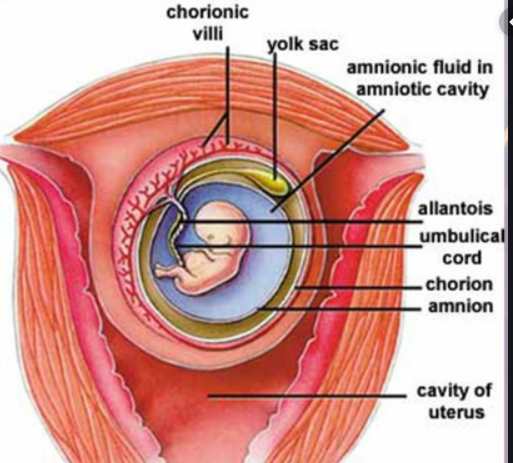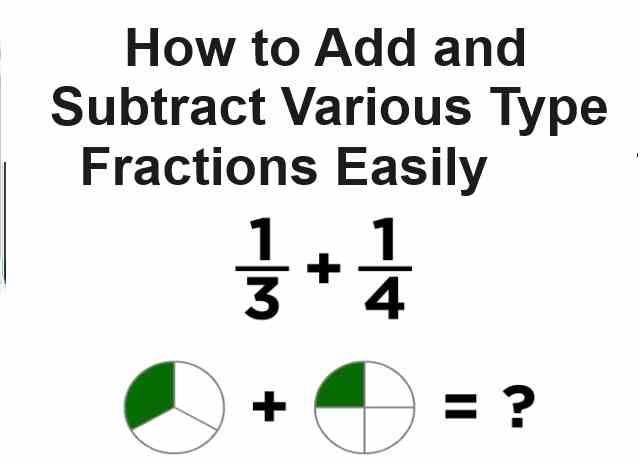Reproductive System ICSE Class-10 Concise Selina Biology Solutions Chapter-13. We Provide Step by Step Answer of Progress Check , MCQs, Very Short Answer Type, Short Answer Type, Long Answer Type Questions and Structured / Applications / Skill Type Questions of Exercise-13 Reproductive System ICSE Class-10 . Visit official Website CISCE for detail information about ICSE Board Class-10.
| Board | ICSE |
| Publications | Selina Publishers PVT LTD |
| Subject | Concise Biology |
| Class | 10th |
| writer | HS Vishnoi |
| Chapter-13 | Reproductive System |
| Topics | Solutions of MCQs, Very Short ,Descriptive and Structural/Skill Questions, Think and connect and Progress check |
| Edition | 2021-2022 |
Reproductive System ICSE Class-10 Concise Selina Biology Solutions Chapter-13
-: Select Topics :-
E.STRUCTURED/APPLICATION/SKILL TYPE
Reproductive System Selina Biology for ICSE Class 10 Chapter-13
A. MULTIPLE CHOICE TYPE
Page 181
Question 1
Which one of the following is the correct route that a sperm follows when it leaves the testis of a mammal?
(a) Vas deferens epididymis urethra
(b) Urethra epididymis vas deferens
(c) Epididymis urethra vas deferens
(d) Epididymis vas deferens urethra
Answer 1
(d) Epididymis vas deferens urethra
Question 2
When pregnancy does not occur, the life of corpus luteum is about:-
(a) 4 days
(b) 10 days
(c) 14 days
(d) 28 days
Answer 2
(d) 28 days
Question 3
In female, after how much time after fertilization, does the fertilized egg get implanted in the uterine wall?
(a) Few months
(b) One month
(c) Three weeks
(d) About seven days
Answer 3
(d) About seven days
Question 4
The middle piece of sperm provides:
(a) energy
(b) food
(c) gene
(d) chromosomes
Answer 4
(a) energy
Question 5
The normal gestation period in humans is:
(a) 270 days
(b) 290 days
(c) 280 days
(d) 295 days
Answer 5
(c) 280 days
Chapter-13, Reproductive System ICSE Class 10
B. VERY SHORT ANSWER TYPE
Page 181-182
Question 1
Name the following:
(a) The membrane which protects the foetus and encloses a fluid.
(b) The canal through which the testes descend into the scrotum just before birth in human male child.
(c) Uterine wall that is shed during menstruation.
(d) The minute finger-like projections of placenta.
Answer 1
(a) Amnion
(b) Inguinal canal
(c) Endometrium
(d) Villi
Question 2
Rewrite the terms in the correct order so as to be in a logical sequence.
(a) Implantation, ovulation, child birth, gestation, fertilization.
(b) Coitus, ovum, sperm, sperm duct, urethra, vagina.
(c) Sperm duct, penis, testes, sperms, semen.
(d) Puberty, menopause, menstrual, menarche, reproductive age.
(e) Graafian follicle, Ostium, Uterus, Fallopian tube.
Answer 2
(a) Ovulation fertilization implantation gestation child birth
(b) Sperm sperm duct urethra coitus vagina ovum
(c) Testes Sperms Sperm duct Semen Penis
(d) Menarche Puberty Reproductive age Menstruals Menopause
(e) Graafian follicle Ostium Fallopian tube Uterus
Question 3
Give appropriate terms for each of the following:
(a) The onset of reproductive phase in a female.
(b) Rupture of follicle and release of ovum from the ovary.
(c) Monthly discharge of blood and disintegrated tissues in human female.
(d) Process of fusion of ovum and sperm.
(e) Fixing of developing zygote (blastocyst) on the uterine wall.
Answer 3
(a) Menarche
(b) Ovulation
(c) Menstruation
(d) Fertilization
(e) Implantation
Question 4
Match the items in column I with those in column II and write down the matching pairs (some may not match)
| Column I | Column II |
| (a) Acrosome | (i) An embryo which looks like human baby |
| (b) Gestation | (ii) Luteinizing hormone |
| (c) Menopause | (iii) Ovum producing cells |
| (d) Foetus | (iv) Semen |
| (e) Oogenesis | (v) Spermatozoa |
| (f) Ovulation | (vi) Complete stoppage of menstrual cycle |
| (vii) Time taken by a fertilized egg till the delivery of baby |
Answer 4
| Column I | Column II |
| (a) Acrosome | (v) spermatozoa |
| (b) Gestation | (vii) Time taken by a fertilized egg till the delivery of baby |
| (c) Menopause | (vi) complete stoppage of menstrual cycle |
| (d) Foetus | (i) An embryo which looks like human baby |
| (e) Oogenesis | (iii) ovum producing cells |
| (f) Ovulation | (ii) Luteinizing hormone |
Question 5
Name the following:
(a) The body part in which the testes are present in a human male.
(b) The part where the sperms are produced in the testes.
(c) The fully developed part of the ovary containing a mature egg.
(d) The accessory gland in human males whose secretion activates the sperms.
(e) The tubular knot fitting like a cap on the upper side of the testis.
Answer 5
(a) Scrotum
(b) Seminiferous Tubules
(c) Graafian-Follicle
(d) Seminal vesicle
(e) Epididymis
Question 6
Choose the odd one in each of the following:
(a) Oestrogen; progesterone; testosterone; prolactin.
(b) Ovary; fallopian tube; ureter; uterus.
(c) Seminiferous tubule; ovum; epididymis; sperm duct; urethra.
(d) Sperm; implantation; fertilization; ovum; after birth.
(e) Relaxin; cervix dilates; amniotic sac ruptures; child birth; follicle.
Answer 6
(a) Testosterone
(b) Ureter
(c) Ovum
(d) After birth
(e) Follicle
Selina Biology Solution of Chapter-13, Reproductive System for ICSE Class 10
C. SHORT ANSWER TYPE
Page 182
Question 1
(a) State whether the following statements are TRUE (T) or FALSE (F):
(i) Fertilization occurs in vagina. (T/F)
(ii) Uterus is also known as birth canal. (T/F)
(iii) Nutrition and oxygen diffuse from the mother’s blood into the foetus’s blood through amnion. (T/F)
(b) Rewrite any two of the wrong statements by correcting only one word either at the beginning or at the end of the sentence.
Answer 1
(a)
(i) False
(ii) False
(iii) False
(b)
(i) Fertilization occurs in the fallopian tube.
(ii) Vagina is also known as the birth canal.
(iii) Nutrition and oxygen diffuse from the mother’s blood into the foetus’s blood through placenta.
Question 2
Complete the following table by writing the name of the structure or the function of the given structure:
| Structure | Function |
| 1. corpus luteum | 1.—– |
| 2. —– | 2. produces male gametes in mass |
| 3. Leydig cells | 3. —– |
| 4. —– | 4. increases the force in uterine contractions |
| 5. umbilical cord | 5. —– |
| 6. fallopian tube | 6.—– |
Answer 2
| Structure | Function |
| 1. Corpus luteum | 1. secretes progesterone & other hormones to prepare the uterine wall for the receival of the embryo. |
| 2. Testes | 2. produces male gametes in mass |
| 3. Leydig cells | 3. to produce the androgen, testosterone, under the pulsatile control of pituitary luteinizing hormone (LH) |
| 4. Oxytocin | 4. increases the force in uterine contractions during child birth |
| 5. Umbilical cord | 5. connects placenta with foetus |
| 6. Fallopian tube | 6. The site of fertilization for the sperm and ovum |
Question 3
Given below are the names of certain stages/substances related to reproduction and found in human body.
(a) Foetus
- Where is it contained?
- How does it differ from embryo?
(b) Hyaluronidase
- Is it an enzyme or simply a protein?
- What is its function?
(c) Morula
- What is this stage?
- Name the stage which comes next to it.
(d) Amniotic fluid
- Where is it found?
- What are its functions?
(e) Placenta
- What are the two sources that form placenta?
- Name any two main substances which pass from foetus to mother through placenta.
- Name any two hormones it produces.
(f) Implantation
- The development stage that undergoes this process.
- The approximate time after fertilization, when it occurs.
Answer 3
(a) Foetus:
- It is contained in the uterus.
- In foetus, limbs have appeared and resembles the humans unlike the embryo which is a growing or dividing zygote.
(b) Hyaluronidase:
- Enzyme
- It is an enzyme secreted by the sperm that allows the sperm to penetrate the egg.
(c) Morula:
- It is the stage in the development of human embryo which consists of a spherical mass of cells. Blastocyst
(d) Amniotic fluid:
- Between amnion and embryo
- It protects the embryo from physical damage, keeps the pressure all around embryo and prevents sticking of foetus to amnion.
(e) Placenta:
- Placenta is formed by two sets of minute finger like processes called the villi. One set of villi is from the uterine wall and the other set is from the allantois.
- Oxygen and amino acids.
- Progesterone and oestrogen.
(f) Implantation:
- Blastocyst
- It occurs in about 5-7 days after ovulation.
Question 4
Describe the functions of the following:
(a) Inguinal canal
(b) Testis
(c) Ovary
(d) Oviduct
Answer 4
(a) Inguinal canal : It is the canal which allows the descent of testes along with their ducts, blood vessels and nerves into the abdomen.
(b) Testis : Testis is a male reproductive organ. There a pair of testes present in a scrotal sac descended outside the body cavity. Testes produce sperms which are the male gametes.
(c) Ovary : Ovary is a female reproductive organ. It produces ova i.e. female gametes.
(d) Oviduct : A pair of oviduct is present on either side of the uterus. Oviduct carries the released ovum from the ovary to the uterus.
Question 5
Differentiate between:
(a) Semen and sperm
(b) Hymen and clitoris
(c) Uterus and vagina
(d) Efferent duct and sperm duct
(e) Follicle and corpus luteum
(f) Amnion and allantois
(g) Prostate gland and Cowper’s gland
Answer 5
(a) Differences between semen and sperm :
| Semen | Sperm |
| Semen is a milky white fluid which contains sperms and secretions of seminal vesicles. | Sperms are human male gametes which are produced in the testes. |
(b) Differences between hymen and clitoris :
| Hymen | Clitoris |
| Hymen is a thin membrane that partially covers the opening of vagina in young females. | Clitoris is a small erectile structure located in the uppermost angle of vulva in front of the urethral opening. |
(c) Differences between uterus and vagina :
| Uterus | Vagina |
| Uterus is a hollow, pear shaped muscular organ located in the pelvic cavity. | Vagina is the muscular tube extending from the cervix to the outside. |
| It is the site of implantation for the embryo after fertilization. | The vagina receives the male penis and provides entry for the sperms at the time of sexual intercourse. |
(d) Differences between efferent duct and sperm duct :
| Efferent duct | Sperm duct |
| Efferent ducts join to form the epididymis. | Epididymis is continued by the side of the testes to give rise to the sperm duct or vas deferens. |
(e) Differences between follicle and corpus luteum :
| Follicle | Corpus luteum |
| A maturing egg contained in a cellular sac is called the follicle. | The remnant of the ruptured follicle persists and gets converted into a yellow mass called corpus lutuem. |
(f) Differences between amnion and allantois :
| Amnion | Allantois |
| Amnion is a sac which develops around the embryo before the formation of allantois. | Allantois is an extension from the embryo which forms villi of placenta. |
(g) Differences between prostate gland and Cowper’s gland :
| Prostate gland | Cowper’s gland |
| Prostate gland surrounds the urethra in males. | Cowper’s gland opens into urethra in human males. |
| Its alkaline secretion neutralizes acid in female’s vagina. | Its secretion serves as a lubricant. |
Concise Biology Solution of Chapter-13, Reproductive System for ICSE Class 10th
D. LONG ANSWER TYPE
Page 182-183
Question 1
Define the following terms:
(a) Reproduction
(b) Hernia
(c) Ovulation
(d) Puberty
(e) Fertilisation
(f) Hymen
Answer 1
(a) Reproduction : Reproduction is the process of formation of new individuals by sexual or asexual means, which can repeat the process in their own turn.
(b) Hernia : Hernia is an abnormal condition which is caused when the intestine due to the pressure in abdomen bulges into the scrotum through the inguinal canal.
(c) Ovulation : Ovulation is the release of the mature ovum by the rupture of the Graafian follicle.
(d) Puberty : Puberty is the period during which immature reproductive system in boys and girls matures and becomes capable of reproduction.
(e) Fertilisation : The fusion of the male gamete (sperm) and the female gamete (ovum) to form a zygote is called fertilisation.
(f) Hymen : Hymen is a thin membrane which partially covers the opening of the vagina in young females.
Question 2
Distinguish between the following pairs:
(a) Spermatogenesis and oogenesis
(b) Implantation and gestation
(c) Pregnancy and parturition
(d) Placenta and umbilical cord
(e) Identical and fraternal twins
(f) Menarche and menopause
Answer 2
(a) Differences between spermatogenesis and oogenesis :
| Spermatogenesis | Oogenesis |
| It is the process of production of sperms in seminiferous tubules of testes. | It is the growth process in which an ovum becomes a mature egg. |
(b) Differences between implantation and gestation :
| Implantation | Gestation |
| It is the fixing of the blastocyst to the endometrial lining of the uterus or the wall of the endometrium. | It is the time period of development of the embryo in the uterus. |
(c) Differences between pregnancy and parturition :
| Pregnancy | Parturition |
| It is the state of carrying a developing embryo or a foetus within the female body. | It is the process of giving birth to the young ones at the end of the gestation period. |
(d) Differences between placenta and umbilical cord :
| Placenta | Umbilical cord |
| It is disc-like structure attached to the uterine wall. | It is a cord containing blood vessels which connects the placenta with the foetus. |
(e) Differences between identical and fraternal twins :
| Identical twins | Fraternal twins |
| They are produced from one ovum i.e. one developing zygote splits and grows into two fetuses. | They are produced when two ova get fertilized at a time. |
(f) Differences between menarche and menopause :
| Menarche | Menopause |
| It is the onset of menstruation in a young female at about the age of 13 years. | It is the permanent stoppage of menstruation in females at about the age of 45 years. |
Question 3
What is the significance of the testes being located in the scrotal sacs outside the abdomen? Can there be any abnormal situation regarding their location? If so, what is that and what is the harm caused due to it?
Answer 3
Testes are responsible for the production of male gametes i.e. sperms. The normal body temperature does not allow the maturation of the sperms. Being suspended outside the body cavity, the temperature in the scrotal sac is 2 to 3oC which is the suitable temperature for the maturation of the sperms
When it is too hot, the skin of the scrotum loosens so that the testes hang down away from the body. When it is too cold, the skin contracts in a folded manner and draws the testes closer to the body for warmth.
In an abnormal condition, in the embryonic stage, the testes do not descend into the scrotum. It can lead to sterility or incapability to produce sperms.
Question 4
Suppose a normal woman has never borne a child. How many mature eggs would she have produced in her lifetime? Your calculation should be based on two clues:-
(a) Eggs are produced at the rate of 1 egg every 28 days (one menstrual cycle)
(b) A woman’s total reproductive period is 13-45 years.
Answer 4
Total reproductive period = 45 – 13 = 32 years
Total eggs produced = 32 x 12 = 384 eggs approximately
Question 5
What are the secondary sexual characters in the human male and female respectively?
Answer 5
Secondary sexual characters in males:
(i) Beard and moustache
(ii) Stronger muscular built
(iii) Deeper voice
Secondary sexual characters in females:
(i) Breasts in females
(ii) Large hips
(iii) High pitched voice
Question 6
What are the accessory reproductive organs?
Answer 6
The accessory reproductive organs include all those structures which help in the transfer and meeting of two kinds of sex cells leading to fertilization and growth and development of egg up to the birth of the baby.
For example: uterus in females, penis in males.
Question 7
Differentiate between the primary and accessory reproductive organs.
Answer 7
| Primary Reproductive Organs | Accessory Reproductive Organs |
| The primary reproductive organs produce sex cells. | The accessory reproductive organs help in the transfer and meeting of two kinds of sex cells leading to fertilization. |
| The primary reproductive organs do not help in the development of baby. | The accessory organs help in the growth and development of egg up to the birth of baby. |
| Example: Testes in males and ovaries in females. | Example: penis in males, Uterus, vagina in female. |
Question 8
Name and describe very briefly, the stages in the development of human embryo.
Answer 8
(a) After fertilization zygote is formed inside the fallopian tube.
(b) The zygote then divides repeatedly to form a spherical mass of cells known as ‘Morula’.
(c) The morula then develops into a hollow sphere of cells with a surrounding cellular layer and an inner cell mass projecting from it centrally. This stage is known as the ‘blastocyst’. It implants itself into the uterine wall.
(d) From the blastocyst arises an embryo which is around 3 weeks old. It is a tiny organism that hardly resembles human being.
(e) By the end of 5 weeks, the embryo is with a devalued heart and blood vessels.
(f) By the end of 8 weeks, limbs are developed. This stage is known as ‘foetus’.
(g) At the end of nearly 40 weeks i.e. end of gestation period, the infant is born.
Question 9
Is it correct to say that the testes produce testosterone? Discuss.
Answer 9
Testosterone is the male reproductive hormone produced by the interstitial cells or the Leydig cells. These cells are located in the testes. They serve as a packing tissue between the coils of the seminiferous tubules. Therefore, it can be said that the testes produce the male hormone testosterone.
Chapter-13 Reproductive System Selina Biology solution for ICSE Class 10th
E. STRUCTURED/APPLICATION/SKILL TYPE
Page 183-184
Question 1
Given below is a diagram of two systems together in the human body.
(a) Name the systems.
(b) Name the parts numbered 1-10.
(c) Describe the functions of the parts 3, 4, 5 and 6.
(d) What will happen if the part 3 on both sides gets blocked?
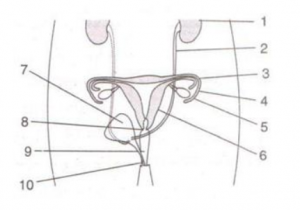
Answer 1
(a) Excretory system and Female Reproductive system
(b)
| 1 | Kidney |
| 2 | Ureter |
| 3 | Fallopian Tube |
| 4 | Infundibulum |
| 5 | Ovary |
| 6 | Uterus |
| 7 | Urinary Bladder |
| 8 | Cervix |
| 9 | Vagina |
| 10 | Vulva |
(c)
(part 3) Function of Fallopian Tube : The fallopian tubes carry the ovum released from the ovary to the uterus.
(part 4)Function of Infundibulum : Infundibulum is the funnel shaped distal end of the ovary which picks up the released ovum and pushes it further on its passage into the fallopian tube.
(part 5) Function of Ovary : Ovary produces female gametes i.e. ova.
(part 6)Function of Uterus : Uterus allows the growth and development of the embryo.
(d) If fallopian tube (part 3) on both sides gets blocked, the ovum released by the ovary will not be pushed into the oviduct and hence, there will be no possibility of fertilisation.
Question 2
The following diagram represents the vertical sectional view of the human female reproductive system.
(a) Label the parts indicated by the guidelines 1 to 8.
(b) How does the uterus prepare for the reception of zygote?
(c) What happens to the uterus, if fertilization fails to take place?
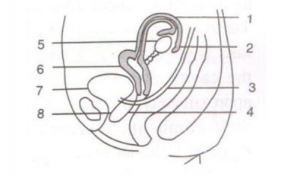
Answer 2
(a)
| 1 | Fallopian Tube |
| 2 | Infundibulum |
| 3 | Ureter |
| 4 | Vagina |
| 5 | Ovary |
| 6 | Uterus |
| 7 | Urinary Bladder |
| 8 | Urethra |
(b) Oestrogen secreted by the corpus luteum secrets oestrogen. Oestrogen stimulates the thickening of the endometrial wall of the uterus. The uterine wall becomes thickened and is supplied with a lot of blood to receive the fertilized egg.
(c) If fertilization fails to take place, the endometrial lining of the uterus starts shedding on the 28th day of the menstrual cycle. Finally it is discharged out along with the unfertilised ovum as the menstrual flow.
Question 3
Given below is the schematic diagram of the sectional view of the human male reproductive system.
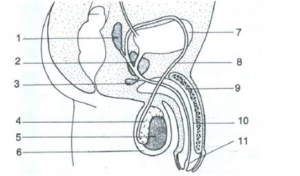
(a) Name the parts numbered 1-11.
(b) State the functions of the parts numbered 1, 2, 3, 5, 8 and 11.
Answer 3
(a) 1 – Seminal vesicles
2 – Prostate gland
3 – Bulbo-urethral gland
4 – Epididymis
5 – Testis
6 – Scrotum
7 – Urinary bladder
8 – Vas deferens
9 – Erectile tissue
10 – Penis
11 – Urethra
(b) Functions of
Seminal vesicles
They produce the fluid which serves as the
transporting medium for sperms.
Prostate gland
It produces an alkaline secretion which mixes with the semen and helps neutralise the vaginal acids.
iii. Bulbo-urethral gland
It produces a secretion which serves as a lubricant for the semen to pass through the urethra.
2. Testis
It produces the male gamete sperm and the male sex hormone testosterone.
Vas deferens
They carry the sperms from the epididymis to the urethra.
3. Urethra
It serves as an outlet for delivering the sperms into the vagina.
Question 4
The diagram below represents two reproductive cells A and B. Study the same and then answer the questions that follow:
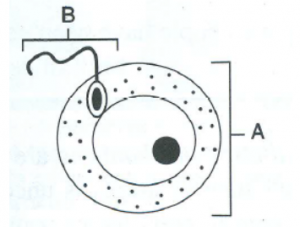
(a) Identify the reproductive cells A and B
(b) Name the specific part of the reproductive system where the above cells are produced.
(c) Where in the female reproductive system do these cells unite?
(d) Name the main hormone secreted by the (1) ovary (2) testes.
(e) Name an accessory gland found in the male reproductive system and state its secretion.
Answer 4
(a) A – ovum
B – sperm
(b) Sperms are produced in the testis.
The ovum is produced in the ovary.
(c) The reproductive cells unite in the fallopian tubes of the female reproductive system.
(d) Ovary – Oestrogen and progesterone
Testis – Testosterone
(d) Accessory glands:
- Seminal vesicle – Seminal fluid
- Prostate gland – Alkaline secretion
- Bulbo-urethral gland – Lubricant
Question 5
The diagram given below is that of a developing human foetus in the womb. Study the same and answer the questions that follow:
(a) Name the parts ‘1’ to ‘5’ indicated by guidelines.
(b) What term is given to the period of development of the foetus in the womb?
(c) How many days does the foetus take to be fully developed?
(d) Mention two functions of the parts labelled ‘2’ other than its endocrine functions.
(e) Name (any one) hormone produced by the part labelled ‘2’.

Answer 5
(a) 1 – umbilical cord,
2 – placenta,
3 – amnion,
4 – mouth of uterus,
5 – muscular wall of uterus
(b) Gestation
(c) 280 days
(d) Placenta provides the foetus with oxygen and nutrients. In addition, the placenta also removes carbon dioxide and waste products of the foetus.
(e) Progesterone
Question 6
Given below is a portion of the diagram to show the diagrammatic highly magnified view of a single human sperm. Complete the diagram to show its internal structure.
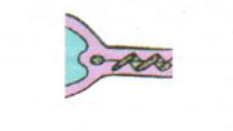
Answer 6
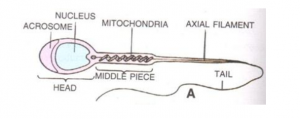
Question 7
Given below is the outline of the male reproductive system. Name the parts labelled 1 to 8 and state their functions. Also name the corresponding structure of part (4) in the female reproductive system.

Answer 7
| Part | Functions |
| 1. (Urinary bladder) |
|
| 2. (Ureter) |
|
| 3. (Bulbo-urethral glands) |
|
| 4. (Sperm duct/Vas deferens) |
|
| 5. (Urethra) |
|
| 6. (Testis) |
|
| 7. (Scrotum) |
|
| 8. (Epididymis) |
|
Fallopian tubes (oviducts) in females are analogous to sperm ducts in males. Sperm ducts carry sperms to the urethra, while fallopian tubes carry ova to the uterus.
Return to Concise Selina ICSE Biology Class-10
Thanks

